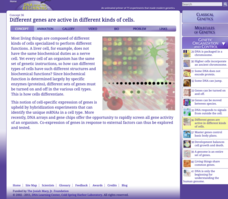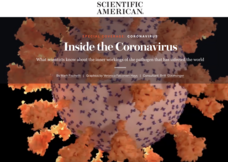Curated OER
Micro-organism Immune System Tag
Students play a game of tag and reinforce their understanding of the immune system.
Curated OER
Immunity From Diseases
In this immunity instructional activity, students review vocabulary associated with how the body defends itself from diseases. This instructional activity has 12 matching questions.
National First Ladies' Library
Every Child By Two: Early Childhood Immunizations
Students investigate the childhood immunizations and how they are used to help prevent the spread of disease. They conduct an information search using a variety of resources and focus upon the problem of disease in children. The research...
Next Generation Science Storylines
Why Don't Antibiotics Work Like They Used To?
Bacteria get more resistant to antibiotics every year. Learn the reason for this pattern and how scientists are addressing the problem in a six-week unit. Learners analyze different types of bacteria and their adaptations.
Curated OER
How Do White Blood Cells Fight Foreign Organisms That Invade Our Body?
Ninth graders investigate the functions of white blood cells. They watch and discuss an online movie, conduct Internet research, and complete a worksheet.
Curated OER
"Writing As Healing" Exercise
Students begin with a teacher-leld discussion of recent research, which has found measurable imporovements in patient symptoms even four monthe after their participation in a brief writing exercise about a stressful event in the...
Curated OER
Investigating the Method by Which the Body Defends Against Pathogens
Students explore disease caused by bacteria and viruses, how they are transmitted, and how they exert their effects on their hosts. They explain how diseases, such as AIDS, are spread by exponential growth.
Curated OER
AIDS, a Modern Day Epidemic
Students discuss global effect of AIDS epidemic, explain how HIV infects the body, and identify the symptoms of AIDS.
Curated OER
Cellular Invaders
For this biology worksheet, learners study the animation on how the body's defense mechanism fight microbes. They write short answers to 8 questions that follow.
Curated OER
Bacteria: Friend or Foe?
Students examine a variety of environmental and industrial roles of bacteria. explore where bacteria can be found and distinguish bacteria from other organisms.
Curated OER
The Immune System
In this health learning exercise, students locate 25 words related to the immune system. Words are hidden in a word search. Students may self correct by selecting the link at the end of the page.
Howard Hughes Medical Institute
The Making of the Fittest: Natural Selection in Humans
Sickle cell disease only occurs when both parents contribute the trait, and mostly in those of African descent. Where did it come from? How did it evolve? Tony Allison, a molecular biologist, noticed a connection between sickle cell and...
Curated OER
Asthma and Allergies
Your health class reads two biographical stories: one about a girl who has allergies and the other about a girl who has asthma. They watch a quick cartoon on the KidsHealth website about immunity and take the related online quiz. You...
Curated OER
Antigen Switching in Malaria
Students model how the malaria-causing protist avoids immune response in its host. In this parasite biology lesson, students use printed cell images to model the way that Plasmodium changes surface protein markers every few generations...
Curated OER
Health and Safety
Students analyze colors and the reasons they are used in preschool room setups. They examine preschool setups, safety procedures, and the immunizations required for preschool.
Curated OER
Human Body Basics
For this human body worksheet, students are given clues to find hidden words in boxes. Topics include the human body systems, the components of living things and the building blocks of life.
Curated OER
Body Systems
In this body systems worksheet, students complete a concept map of the 9 body systems. They are given a word bank and some terms filled in to get them started. Students fill in 16 terms related to the systems.
Curated OER
Fizzies Virus
Sixth graders discover how disease spreads. For this disease control lesson, 6th graders brainstorm a list of diseases and simulate how a disease spreads by using cups of hydrogen peroxide and water. Students create the "Fizzies Virus"...
Curated OER
Using Mathematics to Explain the Spread of Diseases
Learners use statistics to solve problems based on the spread of disease. In this disease lesson students study the role that viruses and bacteria play in the spread of diseases and explain pandemics.
Curated OER
Sexually Transmitted Diseases (STDs), Day 3: HIV/AIDS - Its Impact on People
High schoolers watch a video in which sixteen young people talk about how their lives have been changed by having HIV. So many people have the attitude that it will never happen to them, but no one is immune to this disease. Hopefully...
PLS 3rd Learning
Priceless
The message that buying things brings happiness is everywhere. Teenagers are not immune to this marketing strategy and benefit from reflecting on the relentless pressure to spend. This exercise invites young adults to consider the value...
The New York Times
Sequencing the Stages: Understanding H.I.V. Infection at the Molecular Level
How does HIV operate at the molecular level? Pupils discover the progression from a healthy immune cell to one infected with HIV, watch an animation of the HIV life cycle, and finally identify each of the stages with illustrations...
Cold Spring Harbor Laboratory
Different Genes Are Active in Different Kinds of Cells
Personalized medicine prevents many trial-and-error scenarios when time counts the most. Learn how gene expression and screening genomes improves health outcomes in cancer patients, those with auto-immune disorders, and more. An online...
Scientific American
Inside the Coronavirus
Take biologists on a journey into the heart of the Covid-19 virus with a series of stunning graphics and explanations about the global pandemic. Animations bring investigators up close to the virus, revealing its structure and movement...

























